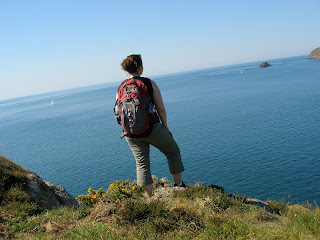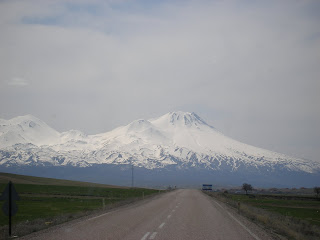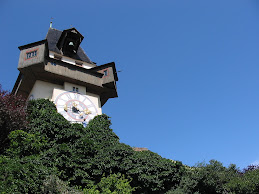I know, I know, it's a totally cheesy heading. I just couldn't resist.
One of the fabulous things about living in Austria is that it was SO easy to pop over to London for my cousin's wedding in May. I took off the last week of school to fly to London (which is ironic, since last year I had to take off a week at the end of my school year in May for my sister's wedding--such bad timing for taking a week off!), hang out with relatives, and then head down to Wales with some family for a few days after the wedding. This was my third trip to London, which was perfect for a wedding; since I'd seen the city twice before, I didn't feel pressured to go out and be a tourist. Instead, I visited with friends in the city and the relatives I rarely get to see. This really made for the perfect London trip. But since I've already been there and done that in London, I thought I'd tell you a bit about Wales instead.
Before I went to Wales, I envisioned a verdant countryside full of rolling hills and sheep. The day after the wedding, we drove in a rented minivan from London to St. David's in Pembrokeshire, on the far southwest coast of Wales, through a verdant countryside full of rolling hills and sheep. Yep, it was pretty much as I'd envisioned it. I'd also somehow gotten the idea that, since Welsh is one of those languages that looks like a grab bag of letters strung together to form words and sentences, the people of Wales would have a funny and barely intelligible accent. Not that I'd ever spoken with anyone from Wales, of course. To the contrary, I found that the Welsh accent just sounded British. However, the Welsh language is everywhere -- on every street sign, in tourist literature, and even on the radio and television; apparently children learn Welsh in school until the age of 16, and everyone I met could speak a bit of the language even if they didn't consider themselves fluent.
St. David's is the smallest city in the UK and the second smallest city in the world, located within Pembrokeshire Coast National Park. With a population of less than 2000 and and a quaint city center, it seems like more of a village than an actual city. But Queen Elizabeth II granted St. David's city status because it had St. David's Cathedral (also aptly named for the city's patron saint), a pilgrimage site built in 1181.
 The ruins of the Bishops's Palace, with St. David's Cathedral and the old city wall in the background
The ruins of the Bishops's Palace, with St. David's Cathedral and the old city wall in the backgroundOur cottage was literally right across from St. David's Cathedral...and conveniently right behind the pub. We really couldn't have been in a better spot! Since the town was so small and walkable, we were able to see the biggest attractions in St. David's on foot (the cathedral and the ruins of the Bishop's Palace), eat (and drink) in the pub when we got hungry, and venture out further towards the coast for more fun and adventure. When I think about what made Wales so great, my mind comes to three things: going coasteering, walking along the coastal path, and meet even more super-interesting people.
Coasteering
I'd never heard of coasteering until I got to Wales. A relatively new adventure sport, the term "coasteering" was coined by a St. David's-based adventure sport company to describe the combined activities of swimming, scrambling, climbing, and cliff jumping at the base of the cliffs along the coastline. (Just as "mountaineering" is the stuff you do on a mountain, "coasteering" is the stuff you do along the coast.) This company also touts itself as the world's first carbon neutral company...which is understandable, since we outfited ourselves at the base and then walked down to the coast and back--it's all manpower, baby!
We were given a wetsuit, a helmet, old sneakers, a ratty pair of shorts to wear over the wetsuit (to protect it from being ripped to shreds on the rocks), and topped it all off with a life vest. Unfortunately I don't have any pictures of this getup, but as you can imagine, it makes for a funny sight. But so necessary. When we had walked down to the coastal cliffs of St. Non's (which is St. David's birthplace), our guide explained to us exactly what was going down. We'd take a fisherman's path down to the water (read: climb down the not-sheer face of the cliff) and then climb across some sharp rocks--being careful not to cut our hands on the barnacles--before jumping into the water breaking at the base of the cliff. From there we'd swim from rock to rock, playing in whirlpools and toilet bowls, jumping from rocks as high as 5 m, and scrabling along the coastal rocks. As the basics were being explained to me, I thought, "Wow, this is pretty much everything your mother told you not to do!"
Basically, you have the potential of being battered or shattered against the rocks at every turn. Or at least, that's what your mother would say. But since you're with a guide, all of these really fun activities somehow seem less stupid.
The water was a brisk 12 degrees Celsius, which was enough to keep my hands sufficiently numbed for the first hour or so (although the wet suit provided sufficient body warmth after I got over the initial shock), which is perhaps why I didn't notice that I actually was ripping my fingers to shreds on the rocks. At the end of our adventure, my fingertips had been sliced to smithereens by what looked like thousands of tiny paper cuts, so I would have been in the perfect position to rob a bank and leave no fingerprints behind...though I didn't plan my time wisely enough to fit that all in. My wetsuit didn't fare any better, and I noticed a few extra tears in the knees that hadn't been there when we set out.
But I was proud of my barnacle-sliced fingertips. It was worth every grunt and every momentary feeling of dread before jumping into lord knows what. Coasteering is such an exciting and unique experience, and I'd do it again in a heartbeat.
 Don't let this serene photo fool you -- there were fiestier waters at hand when we went coasteering!
Don't let this serene photo fool you -- there were fiestier waters at hand when we went coasteering!The Coastal Path
Having been coasteering, I'd already gotten a taste for the shocking beauty of the coast. This was like no coast back home -- it was rich and rugged, high and dramatic, and the waters were a deep and wild azure. I had to go back.
Since none of my relatives wanted to go hiking with me, I bought a few maps and decided to head out our last morning in Wales by myself. I was just a tad bit nervous about this decision, since I would be alone...on a cliff. Not that I had any plans of falling in, but all of those stories of freak winds coming along and pushing people to their dooms or of rural rapists and murderers using such cliffs to get rid of their victims...yeah, I'll admit, a few of these thoughts ran through my head. What made me even more nervous, however, is that I didn't have any appropriate shoes. I'd only brought shoes with me appropriate for city walking...but I decided I wasn't going to let this stop me. The coast was just too spectacular to pass up.
I set out on the last morning in Wales from our cottage, returning to the path leading down to St. Non's that we'd taken the previous day when coasteering. From St. Non's I walked back towards the cliff with the fisherman's path, snaking along the coast until I reached St. Justinian's -- probably a distance of about 6-7 miles.
It was incredible. I soon realized that there was no reason to fret the solitude, but to embrace it. It was perfect. (In fact, I was brought back to my farming experience in Tyrol last summer, when I climbed to the summit of an un-trailed mountain, "alm" by myself (sorry for the German-English pun...even if it's only funny to me, I couldn't resist).) In fact, I didn't run into any other hikers on the path until I was within a half mile of my destination, and by then I actually resented them for intruding on my coast. The coastline awed me at every turn. I suppose that if you're looking at my pictures, after a while it all looks the same. But when I was there and standing on those cliffs carpeted in wildflowers sliding into that deep blue ocean under a clear blue sky, my spirit was joyful and my heart was happy and I was full of praise for such astounding creation. It really gets me.

The magnificence of the scenery testifies to the real power of the landscape: all of this incredible nature was enough to distract me from my burning, blister-ridden feet, which could feel the contour of every rock through the thin, thin soles of my shoes. Fortunately, when I arrived at St. Justinian's, I was just in time to catch the local shuttle bus (which does not tend to run often during the day) back to St. David's. The £1 fare was gladly spent in exchange for the last 2 miles spared my aching feet on the road back to St. David's. And although it took my feet days to recover, it was well worth the pain.

More People Worth Meeting
We arrived in St. David's rather late on our first night in Wales and decided to head over to the pub around 10 pm.
"If we sit in the beer garden, I bet we'll make some new friends!" I said as we were deciding where to sit.
"No we won't," my aunt said quickly and confidently.
But an hour later, after we'd chosen to occupy a few free seats at the end of a table in the beer garden where a couple of musicians were playing, we were all engaged in conversations with the really interesting people around us.
My most interesting conversation, however, was with a guy known to the locals -- as he put it -- as "Crazy Joe." I can't verify that any of his story is true, and it very well could have been one of the best tall tales ever spun, but he was an inspiring character, regardless.
Apparently, this guy was one of the top 5 mountain climbers in the UK, but years ago he scaled a peak with his wife...and she didn't make it down alive. He felt terrible and blamed himself for the accident. In the midst of his depression, he decided to go to Antarctica in an act of self-punishment. This decision, however, started out as exactly that -- a decision. He had no skills and wasn't qualified at all, but he badgered the UK's Antarctic program until they let him in. He went as an engineer, though he wasn't one before, and stayed for 7.5 consecutive years with no visits back to the rest of the world. (Although, allegedly, his father came to visit him once during that time in Antarctica.) Crazy Joe truly loved the freedom of the Antarctic: "It's the only f*ing place on earth where there are no bloody rules!" He found respite there from authority and The Man, and he reveled in it. Re-entry into an organized, regulated society after 7.5 years of total (Antarctic) freedom was difficult for him, but he did have 7.5 years worth of unspent wages upon his return...after all, you can't really spent money while living in Antarctica, can you? So what did Crazy Joe do? He surfed. He came back home and surfed along the Welsh coast for months. When I met him, he was no longer surfing but was trying to sort his life out and figure out what to do. When I asked him what he was considering, he said that he "might have to make art for a living" but couldn't elaborate more. Those of you who know my secret wish to go to Antarctica can understand why wasn't totally put off by his annoying drunken demeanor and kept on chatting with him until the intriguing story came out. His advice for getting to Antarctica when you're not qualified? "Be a f*ing pain in the ass!"
The other person I met who spoke to a secret wish of mine was the travel writer. If you've known me for more than 5 minutes then you've probably ascertained that I like to travel. If you're reading this blog, well then, you know I like to write. So it's no big jump to conclusions to assume that I've toyed with the idea of travel writing for a long time, but just haven't known where to start. So when I met the travel writer who as "tagging along" on the coasteering trip for the travel guide he was working on, you can imagine my enthusiasm. Though I tried to show a dose of composed restraint, I pretty much kept the questions coming, concluding with an apologetic, "So do people always pick your brain like this when they find out you're a travel writer?" Surprisingly, they do not. His biggest advice for someone trying to break into travel writing is just to write -- there's bound to be someone out there who will take your work! Somehow it wasn't until I was talking to him that it became clear to me that travel writing tends to be lonely business -- you do most of your travelling alone unless you're writing for a publication big enough to have a photographer with you. Although traveling alone is not really my thing, I think I could hack it for the sake of being a travel writer. Now just to figure out where to start...





























